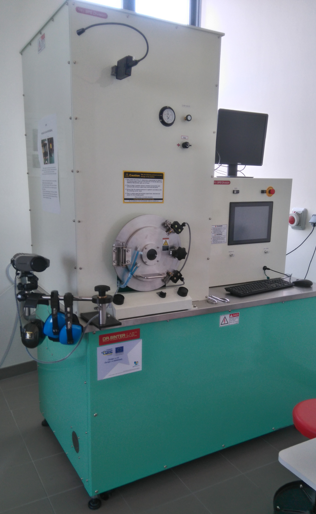Spark plasma sintering equipment
GREMAN laboratory was recently equipped with a 632Lx "Spark Plasma Sintering" SPS sintering machine from Fuji Electronics, unique in the Loire Valley region.
Sintering by "Spark Plasma Sintering" consist in placing a powder batch in a cylindrical graphite die covered with thin graphite paper, and between two graphite punches. A pulse alternating current (from 0 to 3000A) is injected through the graphite electrodes, and thanks to various mechanisms and activated processes, still under investigation and debate, rapid grain consolidation occurs.
In the most probable scenario for oxides, due to their limited electrical conductivity, the die is heated by Joule effect which is then transmitted to the sample. The effect of the mechanical pressure (0.5 to 60kN is from 0 to 300MPa depending on the dies dimensions) applied during the sintering cycle increases the densification by suppressing the porosities and enhancing the diffusion phenomena. The temperature is monitored close to the sample by thermocouple or pyrometer control and the sintering tracking ΔL=f (T) is measured in situ.
Relative densities close to 100% can be easily achieved in 5 to 15 minutes dwell time, at temperatures lower than conventional sintering, and in confined conditions that can preserve from elements volatilization.
Ref : « High electromechanical performance with spark plasma sintering of undoped K0.5Na0.5NbO3 ceramics » M. Bah, F. Giovannelli, F. Schoenstein, G. Feuillard, E. Le Clezio, I. Monot-Laffez - Ceramics International Vol. 40 (2014) pp. 7473–7480.


SPS 632 Lx equipment and the die-electrodes-thermocouple assembly.


Microstructures of (K,Na)NbO3 piezoelectric ceramics, SPS sintered 200°C lower than the conventional sintering temperatures, with 96-97%. relative densities
Sintering by "Spark Plasma Sintering" consist in placing a powder batch in a cylindrical graphite die covered with thin graphite paper, and between two graphite punches. A pulse alternating current (from 0 to 3000A) is injected through the graphite electrodes, and thanks to various mechanisms and activated processes, still under investigation and debate, rapid grain consolidation occurs.
In the most probable scenario for oxides, due to their limited electrical conductivity, the die is heated by Joule effect which is then transmitted to the sample. The effect of the mechanical pressure (0.5 to 60kN is from 0 to 300MPa depending on the dies dimensions) applied during the sintering cycle increases the densification by suppressing the porosities and enhancing the diffusion phenomena. The temperature is monitored close to the sample by thermocouple or pyrometer control and the sintering tracking ΔL=f (T) is measured in situ.
Relative densities close to 100% can be easily achieved in 5 to 15 minutes dwell time, at temperatures lower than conventional sintering, and in confined conditions that can preserve from elements volatilization.
Ref : « High electromechanical performance with spark plasma sintering of undoped K0.5Na0.5NbO3 ceramics » M. Bah, F. Giovannelli, F. Schoenstein, G. Feuillard, E. Le Clezio, I. Monot-Laffez - Ceramics International Vol. 40 (2014) pp. 7473–7480.


SPS 632 Lx equipment and the die-electrodes-thermocouple assembly.


Microstructures of (K,Na)NbO3 piezoelectric ceramics, SPS sintered 200°C lower than the conventional sintering temperatures, with 96-97%. relative densities


